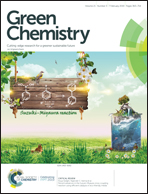Quantitative glucose release from softwood after pretreatment with low-cost ionic liquids†
Abstract
Softwood is an abundantly available feedstock for the bio-based industry. However, achieving cost-effective sugar release is particularly challenging, owing to its guaiacyl-only lignin. Here, we report the highly effective pretreatment of the softwood pine (Pinus sylvestris) using ionoSolv pretreatment, a novel ionic liquid-based lignocellulose fractionation technology. Three protic, low-cost ionic liquids, 1-butylimidazolium hydrogen sulfate, triethylammonium hydrogen sulfate and N,N-dimethylbutylammonium hydrogen sulfate, were used to fractionate the biomass into a carbohydrate-rich pulp and a lignin. The carbohydrate-rich pulp was hydrolysed into fermentable sugars by enzymatic saccharification. Under the most successful pretreatment conditions, quantitative glucose release from the pulp was achieved, which equates to a projected glucose release of 464 mg per gram of pine wood entering the process. We further intensified the process by increasing the solid to solvent ratio up to 1 : 2 g g−1 while maintaining saccharification yields of 75% of the theoretical maximum. We also demonstrate for the first time that N,N-dimethylbutylammonium hydrogen sulfate, [DMBA][HSO4], is an excellent low-cost pretreatment solvent, surpassing the pretreatment effectiveness of its symmetrically substituted analogue triethylammonium hydrogen sulfate. This shows that ionoSolv pretreatment with protic hydrogen sulfate ionic liquids is a truly feedstock-independent pretreatment option, further increasing the commercial potential of this pretreatment technology.



 Please wait while we load your content...
Please wait while we load your content...